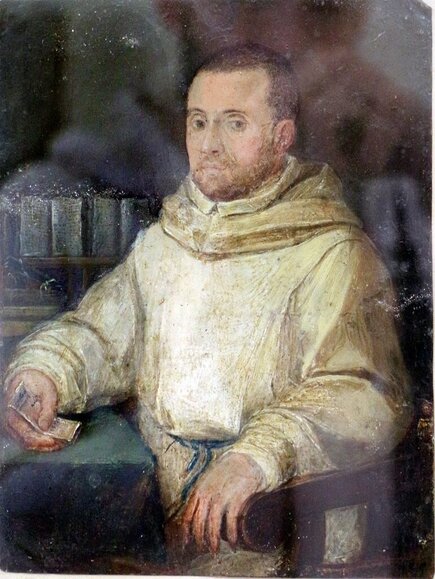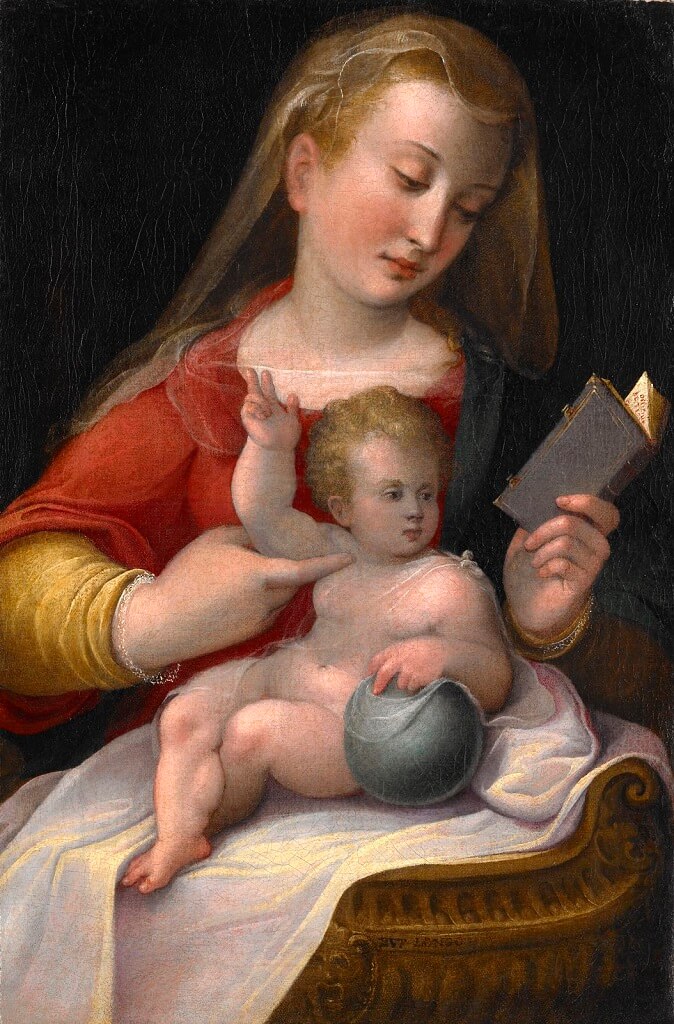|
Where? Ravenna Art Museum
When? 1570 or 1573 Medium: oil on copper, 16.5 x 13 cm. What do you see? The monk looks out with eyes that draw our attention. He appears stern and sober, and his short beard may indicate that he is relatively new to the order. He wears a blue waistband and holds a piece of paper in his right hand. The paper's content is largely illegible, but just below his thumb, we can identify some text reading "157.". It refers to the year this work was painted, but the last digit is hard to read. The books at the end of the table and on the shelf behind him are indicative of his education and knowledge, which would have been deeply respected.
Backstory: This would have been a small devotional piece, and the owner would have had no trouble contemplating him or herself and their religious thoughts when looking at this simple yet profound portrait. Barbara Longhi painted this portrait on copper to create a luminous background, but poor preservation has resulted in a loss of luster. Longhi's paintings reflect the authoritarian ideas of the Counter-Reformation, according to which religious images should be simple and unambiguous to elicit a devotional response from the viewer.
Camaldolese Order: The monk was a member of the monastic order of the Camaldolese (in Camaldoli), founded by the Benedictine St. Romualdo from Ravenna. Their aim was to build a refuge for pilgrims and wayfarers in the isolation of the forest in the mountains about 70 miles southwest of Ravenna. The order was established by 1080. Who is Longhi? Barbara Longhi (1552-1638) was the daughter of the Mannerist artist Luca Longhi (1507-1580), who trained her and her brother Francesco (1544-1618). They lived in Ravenna, about 125 km south of Venice. Barbara assisted her father by serving as a model and helping him with his art, particularly his altarpieces. She also was responsible for promoting his work to potential patrons. She eventually became an artist in her own right, although she remained closely associated with her father's workshop and continued collaborating with him. Following her father's death, she continued her career and supported herself successfully. Barbara was one of the few female artists mentioned by Giorgio Vasari in the 1568 version of his book "Lives of the Most Excellent Painters, Sculptors, and Architects." Vasari praised the teenager for her "purity of line and soft brilliance of color." A few years later, the Italian poet Muzio Manfredi mentioned that Barbara's father was impressed by her portrait paintings. She drew her inspiration from her father and the works of Correggio, Parmigianino, and Raphael. She was well-known in Ravenna, but her reputation did not spread much further. Most of her works were small, and her Madonna and Child paintings were fairly popular (see two examples below). These are characterized by simple compositions and forms. Her soft palette reflects the sfumato technique that Da Vinci made famous. It also confirms her place in the Renaissance as she never totally embraced the Mannerism of her father. She focused on capturing human interactions more naturally than most of her colleagues and especially excelled at expressing motherly love.
Fun fact: Barbara Longhi's personal life is elusive, and most of what is known about her is derived from the paintings attributed to her. There are fifteen known works, twelve of which are small religious paintings she completed. Many are part of the collection of the Ravenna Art Museum, which owns seven of her works. Her other works are part of museum collections in Milan, Bologna, Paris, Baltimore, and Indianapolis.
Written by Carol Morse and Eelco Kappe
References:
0 Comments
Leave a Reply. |
Categories
All
|
- Home
- Blog
-
Museums
- Alte Pinakothek
- Art Institute of Chicago
- Baltimore Museum of Art
- Barber Institute of Fine Arts
- Bargello
- Barnes Foundation
- British Museum
- Church of Sant’Anastasia
- Cleveland Museum of Art
- Courtauld Institute of Art
- Detroit Institute of Arts
- Frans Hals Museum
- Galleria Borghese
- Gallerie dell'Accademia
- Getty Museum
- Guggenheim
- Hermitage Museum
- Kunsthistorisches Museum
- Kunstmuseum Basel
- Legion of Honor Museum
- Louvre
- Mauritshuis
- Metropolitan Museum of Art
- Musee d’Orsay
- Museum of Fine Arts in Boston
- Museum of Modern Art
- National Gallery in London
- National Gallery of Art
- National Museum in Poznań
- Norton Simon Museum
- Ny Carlsberg Glyptotek
- Palace of Versailles
- Palazzo Pitti
- Palazzo Vecchio
- Petit Palais
- Philadelphia Museum of Art
- Prado
- Pushkin Museum
- Ravenna Art Museum
- Rijksmuseum
- San Diego Museum of Art
- Santa Maria delle Grazie
- St. Peter's Basilica
- Städel Museum
- Statens Museum for Kunst
- Tate Britain
- Tate Modern
- Timken Museum of Art
- Uffizi
- Vatican Museums
- Wallace Collection
-
Artists
- Altdorfer
- Anguissola
- Berlin Painter
- Bosch
- Botticelli
- Boucher
- Bronzino
- Bruegel the Elder
- Brunelleschi
- Cabanel
- Caillebotte
- Canova
- Caravaggio
- Carpeaux
- Cezanne
- Cimabue
- David
- Degas
- Delacroix
- De Maria
- Donatello
- El Greco
- Fontana
- Fra Angelico
- Fragonard
- Gauguin
- Gentileschi
- Gericault
- Gonzalez-Torres
- Goya
- Hals
- Hogarth
- Hokusai
- Ingres
- Leonardo da Vinci
- Lippi, Filippo
- Longhi, Barbara
- Lorrain
- Makovsky
- Manet
- Massys
- Matisse
- Merian
- Michelangelo
- Mochi
- Modigliani
- Monet
- Panini
- Parmigianino
- Perugino
- Picasso
- Pisanello
- Raphael
- Rembrandt
- Renoir
- Reynolds
- Rivera
- Rodin
- Rubens
- Scultori
- Seurat
- Steen
- Tintoretto
- Titian
- Toulouse-Lautrec
- Turner
- Uccello
- Van der Weyden
- Van Dyck
- Van Eyck
- Van Gogh
- Van Hemessen
- Vasari
- Velazquez
- Vermeer
- Veronese
- Vigée Le Brun
-
Locations
- Books
- About Us



